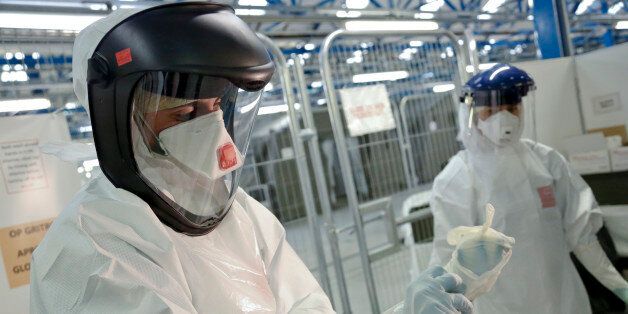
A year after the 2014 Ebola outbreak, GHIA (Global Healthcare Innovation Alliances) maps the unexpectedly broad alliances formed to combat the disease and considers their implications for future global health crises.
The global response to the 2014 Ebola outbreak was unusual. Mobilization of key players was relatively fast and once they entered the game these players -- and the groundbreaking web of partnerships that emerged -- accelerated the development and deployment of Ebola vaccines in unprecedented ways.
GHIA at Duke University has spent the past year following the interplay between the multiple players involved in the funding, development, manufacturing and distribution of Ebola vaccines.
Typically, the average approval time for a new vaccine is around 8 ½ to 15 years, at best. Licensing agreements between inventors and sellers take anywhere from 6 to 12 months to negotiate, or more. Several Ebola vaccine candidates reached the clinic in less than a year, due primarily to the synergies created by the consortia and partnerships formed by companies like GlaxoSmithKline and Johnson & Johnson. These vaccines were supported by entities including the Gates Foundation and the Wellcome Trust, developed by academic institutions including Cambridge University, the London School of Hygiene and Tropical Medicine, and several other parties such as Doctors Without Borders and the European Union's Innovative Medicines program.
Some parties played multiple roles, such as the National Institutes of Health and GSK, and companies are the manufacturers, such as Bavarian Nordic and NewLink. These numerous parties came together in a few scant months to swiftly address a growing global health crisis.
Pre-existing formal and informal relationships between many of the parties set the groundwork for the rapid formation of consortia that enabled this extraordinarily fast and broad response. As fear-inducing headlines spread around the world in mid-2014, the first Ebola consortia were announced. From the beginning, it became clear that these alliances were much wider across functions and borders than responses to any previous global epidemics.
The diversity of the members of these consortia had the potential to mire the negotiations and efforts in thickets of bureaucracy. However, they instead created a wave of efforts and capabilities in the pursuit of a common goal. Understanding this achievement will help global health players in addressing future disease outbreaks.
The consortium led by British pharmaceutical company GlaxoSmithKline (GSK) was itself spawned by the accidental acquisition of an Ebola vaccine. In 2013, GSK had acquired Okairos, a vaccine platform company that was already working on an Ebola vaccine, a move that put GSK in a poll position, enabling it to act quickly after the March 2014 outbreak. GSK's extensive network formed an alliance of functions around this vaccine candidate.
WT has now been working for about a year with two vaccines: both Merck's and GSK's, and has provided an emergency Ebola funding package of nearly $16 million. The Trust has started a rapid response research fund to address treatments, how infection spreads, prevention and diagnostics, working with multiple partners. These broader ways of partnering are changing the race to address global health crises. With the initial Ebola vaccine, the speed of the process was unique - it took place over the course of a mere 9 weeks, and approvals were granted within 4 weeks of submission.
Under normal circumstances, the number of formal agreements required to designate rights and obligations between entities like GSK or the WT and other participants in global health partnerships would normally have taken years to complete. In the Ebola case at least two major factors contributed to the unusual fast response: first, the parties began acting before the agreements were finalized given the urgency of the situations; and second, they agreed on the sharing of rights and obligations at an unheard of speed. This shows how therapies for medical emergencies can be accelerated by broad partnerships when the will is present (and, more somberly), when the developed world awakens to fear-inducing headlines about regional outbreaks in other regions of the world.
Nevertheless, even these swiftly formed and relatively well funded consortia encountered social, structural, medical and scientific road blocks. Not all players were equally fast in their responses to Ebola. Global health institutions, including the World Health Organization, were loudly criticized for being less nimble in responding to the outbreak, due to funding constraints and internal bureaucracy. Structures and dynamics, associated with economic limitations, are however, not the sole obstacles that global health institutions face in efficiently responding to major health crises. The global health system suffers from various ailments, from understaffed health workforces, inefficiencies in data collection and sharing, and static partnership models, among other. Simply put, in global health crisis like the Ebola epidemic, one entity cannot provide disease-specific infrastructure, development and funding alone.
Ebola is retreating to the back burner of global health concerns. So how do we turn the lessons learned from the 2014 outbreak into a map for the future? GHIA is now turning these lessons into blueprints for partnering in the fight against the next global outbreaks.
From the depths of a devastating disease, an unplanned case study in overcoming a disconnected system to deal with global health crises has emerged. The success of and learnings from these alliances of parties, who have together accelerated the development and vaccines to availability, provides a path, that, along with more focused and consistent resources behind in the future, provide more effective parameters for fighting future global epidemics.